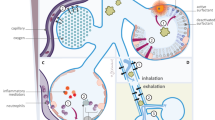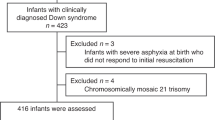Abstract
There is a paucity of information on long-term outcome of infants who have suffered from meconium aspiration syndrome (MAS) in the neonatal period. We analyzed long-term developmental outcome data of 35 infants who were admitted to the neonatal intensive care unit (NICU) at the University of Illinois Hospital at Chicago (UICMC) with a diagnosis of MAS, and we reviewed the literature pertinent to the subject. The objective of the study was to assess the neurodevelopment status of MAS infants and compare the possible effects of different variables that are known to affect the later developmental outcome. The variables included mode of delivery, APGAR score, cord pH, mode of treatment, and neurological findings during the course of NICU. The infants were enrolled in the developmental follow-up program (DFUP) after discharge from the nursery for assessment of long-term developmental status and neurodevelopmental outcome. In order to assess the impact of the treatment on long-term outcome and compare our findings with previously published reports, we also reviewed the previously published literature on neurodevelopment outcome of infants treated for MAS (with different modalities) during the last three decades. Total of 35 infants with a diagnosis of MAS admitted to the NICU at UICMC were followed in the DFUP clinic for 3 years during January 1999 to September 2001. The medical records of these infants were reviewed for the mode of delivery, APGAR score, birth weight (BW), gestational age, mode of treatment during the neonatal period, and neurodevelopment status. 19/35 (54%) infants were delivered vaginally, 16/35 (46%) by cesarean section (C-section). All were treated in the delivery room using the standard resuscitation protocol. Following initial resuscitation, all except three required intubation and ventilation for varying duration. One infant required inhaled nitric oxide therapy, and two required extracorporeal membrane oxygenation treatment. Subsequent to discharge, the infants were evaluated in the clinic at 2 months of age, and then every 4 months up to 3 years. The developmental assessment of mental development index (MDI), psychomotor development index (PDI), and behavior rating scale (BRS) were obtained using the Bayley II infant motor scale, and neurodevelopment evaluation was performed using the Amiel–Tison technique. Speech evaluation was performed in infants >18 months using the Rossetti Infant–Toddler language scale. Infants were considered normal when MDI and PDI scores were >85 to 110; mildly delayed when scores were >70 to 84; and severely delayed if the scores were <69. In addition, neurological evaluation also confirmed the disability. The report is based on the final analysis of 29 infants. Data of six infants were not included in the final analysis because of incomplete information. The mean BW of the infants was 3269±671 g; mean gestational age was 39.5±3.1 weeks. The median APGAR score at 1′ was 4, and at 5′ was 6. Out of 29, 11 (38%) infants were normal. Out of 29, 2 infants (7%) had cerebral palsy (CP) and 4 (14%) had severe delay at 12 months of age. Out of 29, 2 who were neurologically disabled had PDI <69. Out of 29, 12 (41%) had mild delay in speech. No statistical difference in neurodevelopment was found in infants born vaginally or by C-section. Our findings show poor outcome (CP and global delay) in 21% of infants who suffered MAS, even though the majority of the infants (26/29) responded to conventional ventilator support alone. No difference was found in the outcome of infants between NSVD vs C-section delivery. These findings suggest that infants with the diagnosis of MAS manifest later neurodevelopmental delays, even if they respond well to conventional treatment. This abstract was presented at the Society for Pediatric Research Annual Meeting, 2000.
This is a preview of subscription content, access via your institution
Access options
Subscribe to this journal
Receive 12 print issues and online access
$259.00 per year
only $21.58 per issue
Buy this article
- Purchase on Springer Link
- Instant access to full article PDF
Prices may be subject to local taxes which are calculated during checkout
Similar content being viewed by others
References
Cleary GM, Wiswell TE . Meconium stained amniotic fluid and the MAS: an update. Ped Clin North Am 1998; 45 (3): 511–525.
Sriram W, Khoshnood B, Singh JK, Msieh HL, Lee KS . Racial disparity in meconium stained amniotic fluid and MAS in the US, 1989–2000. Obstet Gynecol 2003; 102 (6): 1262–1267.
Amiel-Tison C, Grenier A . Neurological Assessment During First Year of Life. Oxford Press: New York, 1979.
Bayley NM . Bayley Scales of Infant Development. New York: 2nd edn, Psychological Corporation: San Antonio, 1963.
Rossetti L . Infant Toddler Language Scale. East Moline Illinois Linguisystems. Rosetti Louis: Illinois, 1990.
Bloom RS, Cropley C . Textbook of Neonatal Resuscitation, 4th edn, Elk. Grove Village, IL: American Heart Association, American Academy of Pediatrics, 2000.
Berkus MD, Langen O, Samueloff A, Xenakis EM, Field NT, Ridgway LE . Meconium stained amniotic fluid: increased risk for adverse neonatal outcome. Obstet Gynecol 1994; 84: 115.
Wiswell TE, Bent RC . Meconium staining and meconium aspiration syndrome. Ped Clin North Am 1993; 40: 957.
Bascik RD . Meconium aspiration syndrome. Pediatr Clin North Am 1977; 24: 467.
Vidyasagar D, Yeh T, Harris V, Pildes R . Assisted ventilation in infants with meconium aspiration syndrome. Pediatrics 1975; 56: 208.
Pierce J, Gaudier FL, Sanchez R . Intrapartum amnioinfusion for meconium stained fluid: meta analysis of prospective clinical trials. Obstet Gynecol 2000; 95: 1051–1056.
Ting P, Brady JP . Tracheal suction in meconium aspiration. Am J Obst Gynecol 1975; 122: 767–771.
Carson BS, Loosey RW, Bowes Jr WA, Simmons MA . Combined obstetric and pediatric approach to prevent meconium aspiration syndrome. Am J Obstet Gynecol 1976; 126: 712–715.
Marshall R, Tyrala E, McAlister W, Sheehan M . MAS neonatal and follow-up study. Am J Obstet Gynecol 1978; 131 (6): 672–676.
Brett C, Dekle M, Leonard CM, Clark C, Snederman S, Roth R et al. Developmental follow-up of hyperventilated neonates: preliminary observations. Pediatrics 1981; 68 (4): 588–591.
Walsh-Sukys MC, Bauer RE, Cornell DJ, Friedman HG, Stork EK, Hack M . Severe respiratory failure in neonates: mortality and morbidity rates and neurodevelopmental outcomes. J Pediatr 1994; 125 (1): 104–110.
Bartlett RH, Roloff DW, Connell RG, Andrews AT, Dillon PW, Zwischenberger JB . Extracorporeal circulation in neonatal respiratory failure: a prospective randomized study. Pediatrics 1985; 76: 479–487.
Towne BH, Lott IT, Hicks DA, Healey T . Long term follow-up of infants and children treated with ECMO: a preliminary report. J Pediatr Surg 1985; 20 (4): 410–414.
Andrews AF, Nixon CA, Cilley RE, Roloff DW, Bentlett DH . One to three year outcomes for 14 neonatal survivors of ECMO. Pediatrics 1986; 78 (4): 692–698.
Hofkosh D, Thompson AE, Nozza RJ, Kemp SS, Bowen A, Feldman HM . Ten years of extracorporeal membrane oxygenation: neurodevelopmental outcome. Pediatrics 1991; 87 (4): 549–555.
Wilden SR, Landry SH, Zwischenberger JB . Prospective, controlled study of developmental outcome in survivors of extracorporeal membrane oxygenation: the first 24 months. Pediatrics 1994; 93 (3): 404–408.
Bernbaum J, Schwartz IP, Gerdes M, D’Agostino JA, Coburn CE, Polin RA . Survivors of extracorporeal membrane oxygenation at 1 year of age: the relationship of primary diagnosis with health and neurodevelopmental sequelae. Pediatrics 1995; 96 (5 Part 1): 907–913.
Robertson C, Finer N, Sauve RS, Whitfield MF, Belgaumkar TK, Synnes AR et al. Neurodevelopmental outcome after neonatal extracorporeal membrane oxygenation. CMAJ-JAMC 1995; 152 (12): 1981–1988.
Ikle L, Ikle DN, Moreland SG, Fashaw LM, Waas N, Rosenberg AR . Survivors of neonatal extracorporeal membrane oxygenation at school age: unusual findings on intelligence testing. Dev Med Child Neurol 1999; 41: 307–310.
Nield TA, Langenbacher D, Poulsen MK, Platzker AC . Neurodevelopmental outcome at 3.5 years of age in children treated with extracorporeal life support: relationship to primary diagnosis. J Pediatr 2000; 136 (3): 338–344.
Vaucher Y, Dudell GG, Bejar R, Gist K . Predictors of early childhood outcome in candidates for extracorporeal membrane oxygenation. J Pediatr 1996; 128 (1): 109–117.
Bennett CE, Johnson A, Field DJ, Elbourne D . UK Collaboratie ECMO Trial Group. UK collaborative randomized trial of neonatal ECMO, follow-up at 4 years of age. Lancet 2001; 357 (9262): 1094–1096.
Rais-Bahrami K, Wayner AF, Coffman C, Glass P, Short BL . Neurodevelopmental outcome in ECMO v/s Near ECMO patients at 5 years of age. Clin Pediatr 2000; 39 (3): 145–152.
Glass P, Wagner AE, Papero PH, Rajasingham SR, Civitello LA, Kjaer MS et al. Neurodevelopmental status at age five years of neonates treated with extracorporeal membrane oxygenation. J Pediatr 1995; 127 (3): 447–457.
Blackwell SC, Modenhauer J, Hassan SS, Redman ME, Refuerzo JS, Berry SM et al. Meconium aspiration syndrome in term neonates with normal acid base status at delivery: is it different? Am J Obstet Gynecol 2001; 184 (7): 1422–1425.
Casey BM, Goldaber KG, McIntire DD, Leveno KJ . Outcomes among term infants when two-hour postnatal pH is compared with pH at delivery. Am J Obstet Gynecol 2001; 184 (3): 447–450.
Roberts JD, Polaner DM, Lang P, Zapor WM . Inhaled nitric oxide in PPHN of the newborn. Lancet 1992; 340: 818–819.
Kinsella JP, Neish SR, Shaffer F, Abman SH . Low dose inhalational inhaled INO in PPHN of the newborn. Lancet 1992; 340: 819–820.
Rosenberg A . Outcome in term infants treated with inhaled nitric oxide. J Pediatr 2002; 140 (3): 284–287.
Rosenberg A, Kennaugh J, Moreland SG . Longitudinal follow-up of a cohort of newborn infants treated with inhaled nitric oxide for persistent pulmonary hypertension. J Pediatr 1997; 131 (1): 70–75.
The Neonatal Inhaled Nitric Oxide Study Group Journal of Pediatrics. Neonatal inhale. Group inhaled nitric oxide. Neurodevelopmental follow-up of NINOS. Pediatrics 2000; 136(5): 611–617.
Ellington M, O’Reilly D, Allred EN, McCormick MC, Wessel DL, Kourembanas S . Child health status, neurodevelopmental outcome, and parental satisfaction in a randomized, controlled trial of nitric oxide for persistent pulmonary hypertension of the newborn. Am Acad Pediatr 2001; 107 (6): 1351–1356.
Lipkin PH, Davidson D, Spivak L, Straube R, Rhines J, Chang CT . Neurodevelopmental and medical outcomes of persistent pulmonary hypertension in term newborns treated with nitric oxide. J Pediatr 2002; 140 (3): 306–310.
Ichiba H, Matsunami S, Itoh F, Ueda T, Ohsasa Y, Yamano T . Three-year follow-up of term and near term infants with inhaled nitric oxide. Pediatr Int 2003; 45 (3): 290–293.
Neonatal Inhaled Nitric Oxide Study Group. Inhaled nitric oxide in full-term and nearly term infants with hypoxic respiratory failure. N Engl J Med 1997; 336: 597–604.
Ghidini A, Spong CY . Severe meconium aspiration syndrome is not caused by aspiration of meconium. Am J Obstet Gynecol 2001; 185 (4): 931–938.
Acknowledgements
This study was partially supported by Perinatal Program Grant, IDHS #53789004.
Author information
Authors and Affiliations
Corresponding author
Rights and permissions
About this article
Cite this article
Beligere, N., Rao, R. Neurodevelopmental outcome of infants with meconium aspiration syndrome: report of a study and literature review. J Perinatol 28 (Suppl 3), S93–S101 (2008). https://doi.org/10.1038/jp.2008.154
Published:
Issue Date:
DOI: https://doi.org/10.1038/jp.2008.154
This article is cited by
-
Meconium aspiration syndrome: a comprehensive review
Journal of Perinatology (2023)
-
Efficacy of synthetic surfactant (CHF5633) bolus and/or lavage in meconium-induced lung injury in ventilated newborn rabbits
Pediatric Research (2023)
-
Meconium exposure and autism risk
Journal of Perinatology (2017)
-
“Half a Century of Evolution of Neonatology: A Witness’s Story”
The Indian Journal of Pediatrics (2015)
-
Blood lactate level and meconium aspiration syndrome
Archives of Gynecology and Obstetrics (2015)



